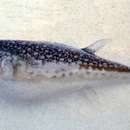en
names in breadcrumbs


There are twenty species of pufferfish in the genus Torquigener, found in shallow waters of the tropical and subtropical Indian Ocean and western Pacific. These puffers have a broad tolerance for salinity; some are found in estuarine and even for short periods in fresh waters.They are small fish, ranging from 9-21 cm (3.5-8 inches) long (Froese and Pauly 2013). Some species are quite common, and generally know by many familiar names, among them toadoes or blow fishes.Large numbers of Torquigender pleurogramma (weeping blowfish) in the Swan River estuary in Perth are considered a nuisance to fishermen (Government of Western Australia 2011).The Torquigener belong to the pufferfish family Tetrodonidae, which includes 19 genera of more than 120 species characterized by four fused front teeth, which form a beak-like structure they use to crush the shells of their mollusc and crustacean prey.They are opportunistic fish and have a wide diet that includes many kinds of other invertebrates as well.Like other tetrodontids, Torquigener puffers fill their elastic stomach with water when aggravated and puff up into a sphere, their soft skin without scales but covered with short spines, so they become uncomfortably inedible and threatening. There is variation among the Torquigener species in numbers of spines; some, like T. perlevis, have almost no spines, whereas T. pleurogramma is covered with dense spines. Some species are poisonous, especially for humans and especially at certain times in their development, as they harbor symbiotic bacteria that produce highly toxic tetrodotoxin in their skin and internal organs.Despite the protection from their toxin and puffing spines, Torquigener species are eaten by large fish, such as tuna (Hardy 1983, Potter et al. 1988).
A new species of Torquigener, as yet unnamed, was discovered in 2011 as the engineers of previously unexplainable “mystery circle” structures, first seen on the sandy sea floor off the coast of the southern Japanese island of Amami-Oshima in 1995.Males of this species were found constructing these elaborate circular nests, up to 2 meters in diamater, by pushing sand with their fins in radially aligned peaks around the nesting site, and decorating them with small shells.The water flow through the channels created by the peaks deposits fine sand grains into the center, where the females lay the eggs.The nests are thought to function as a form of sexual selection through which females choose their mates; despite the huge cost of building the nests, they are only used for one reproductive cycle.For pictures of the nest and of the Torquigener species visit the scientific report (Kawase et al. 1988).
Torquigener is a genus of pufferfishes native to the Indian and Pacific oceans. Males of at least two Torquigener species are known to make elaborate circular nests on the seafloor.[1]
Twenty species are recognized in this genus:
Torquigener is a genus of pufferfishes native to the Indian and Pacific oceans. Males of at least two Torquigener species are known to make elaborate circular nests on the seafloor.